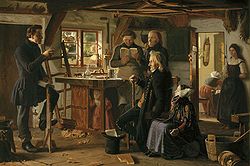
Christian III reigned as King of Denmark from 1534 and King of Norway from 1537 until his death in 1559. During his reign, Christian formed close ties between the church and the crown. He established Lutheranism as the state religion within his realms as part of the Protestant Reformation, and was the first King of Denmark-Norway.

Frederick I was King of Denmark and Norway. He was the last Roman Catholic monarch to reign over Denmark and Norway, when subsequent monarchs embraced Lutheranism after the Protestant Reformation. As king of Norway, Frederick is most remarkable in never having visited the country and was never crowned as such. Therefore, he was styled King of Denmark, the Vends and the Goths, elected King of Norway. Frederick's reign began the enduring tradition of calling kings of Denmark alternatively by the names Christian and Frederick, which has continued up to the reign of the current monarch, Margrethe II.

The Evangelical-Lutheran Church in Denmark or National Church, sometimes called the Church of Denmark, is the established, state-supported church in Denmark. The supreme secular authority of the church is composed of the reigning monarch and Denmark's Parliament, the Folketing. As of 1 January 2023, 72.1% of the population of Denmark are members, though membership is voluntary.
Same-sex marriage has been legal in Denmark since 15 June 2012. A bill for the legalization of same-sex marriages was introduced by the Thorning-Schmidt I Cabinet, and approved by the Folketing on 7 June 2012. It received royal assent by Queen Margrethe II on 12 June and took effect three days later. Denmark was the eleventh country in the world to legalize same-sex marriage. It was the first country in the world to enact registered partnerships, which provided same-sex couples with almost all of the rights and benefits of marriage, in 1989.

Hans Tausen (Tavsen) nicknamed the “Danish Luther” was the leading Lutheran theologian of the Danish Reformation in Denmark. He served as Bishop of Ribe and published the first translation of the Pentateuch into Danish in 1535.
Poul Helgesen was a Danish Carmelite, a humanist and historian. Helgesen was a mendicant monk who at first supported Christian II and the Lutheran reform movement, but later broke with both and wrote warnings against the tyrannical king and the Lutheran preachers. Like his role model Erasmus of Rotterdam, Helgesen found himself in the gray area between Catholicism and Protestantism.
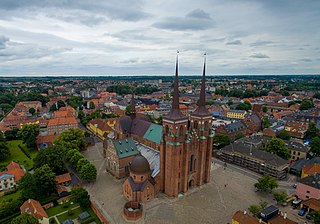
Christianity is the largest religion in Denmark. As of 2022, 72.5% of the population of Denmark were registered members of the Church of Denmark, the officially established church, which is Protestant in classification and Lutheran in orientation.

The Catholic Church in Denmark is part of the worldwide Catholic Church, under the spiritual leadership of the Pope in Rome.

More than 70% of the population of Botswana is Christian. Most are members of the Anglican, United Congregational Church of Southern Africa, the Methodist Church of Southern Africa, and African independent churches. Anglicans are part of the Church of the Province of Central Africa. The Roman Catholic Church includes about 5% of the nation's population.

DanChurchAid is a Danish humanitarian non governmental organisation aimed at supporting the world's poorest. It was founded in 1922, and is rooted in the Danish National Evangelical Lutheran Church. It is a member of ACT Development - a global alliance of over 140 churches and related humanitarian organisations, working to create positive and sustainable change in the lives of poor and marginalized people.
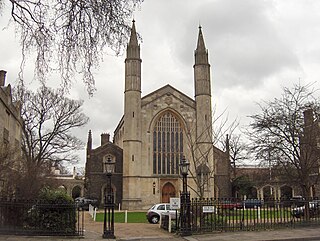
The Danish Church Abroad / Danish Seamen's Church is a Protestant church. It was founded 1 January 2004 as the result of a fusion between the Danish Church Abroad and the Danish Seamen's Church in foreign ports. It was established to help Danes travelling abroad, particularly seafarers and migrant workers.
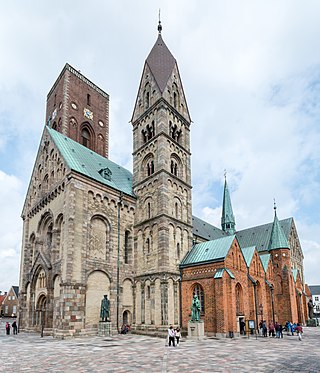
Ribe Cathedral or Our Lady Maria Cathedral is located in the ancient city of Ribe, on the west coast of southern Jutland, Denmark. It was founded in the Viking Era as the first Christian church in Denmark by Ansgar, a missionary monk from Hamburg, under permission of the pagan King Horik I. The cathedral has experienced several damaging events throughout its long history and has been restored, expanded and decorated repeatedly. As it stands today, Ribe Cathedral is the best preserved Romanesque building in Denmark, but reflects a plethora of different architectural styles and artistic traditions. It ranks among the most popular tourist attractions in Denmark and has been awarded two stars in the Michelin guide.
The Ranks and insignia of Royal Danish Army follows the NATO system of ranks and insignia, as does the rest of the Danish Defence. The ranks are based around German and French military terms.
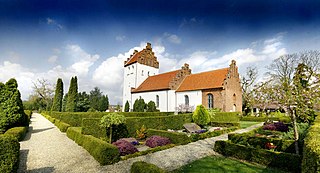
Skjalm Hvide, was the Earl of Zealand in Denmark in the end of the Viking Age (793–1066) and up to his death. Skjalm's father was Toke Trylle, whose father was Slag, based on Absalon, a medieval account scanned, translated and published by Google.

Denmark–Ethiopia relations refers to the current and historical relations between Denmark and Ethiopia. Denmark has an embassy in Addis Ababa, and Ethiopia is represented in Denmark through its embassy in London.
The majority of the Greenlandic population is Christian and associates with the Church of Denmark via the Church of Greenland, which is Protestant in classification and Lutheran in orientation. The Church of Denmark is the established church through the Constitution of Denmark; this applies to all of the Kingdom of Denmark, except for the Faroe Islands, as the Church of the Faroe Islands became independent in 2007. But traditional Inuit spiritual beliefs remain strong in many of Greenland's remote communities.

Peder Palladius was a Danish theologian, Protestant reformer, and bishop of Zealand. As the first protestant bishop in Denmark, he oversaw the conversion of ecclesiastic affairs. He helped create the church ordinance which founded the Church of Denmark, produced a Danish translation of the Bible, and removed Catholic images and rituals from his diocese.

Constituencies are used for elections to the Folketing, the national parliament of Denmark. Denmark proper is divided into 10 constituencies largely corresponding to the Provinces of Denmark, each electing multiple members using open-list proportional representation. Those constituencies are then divided into 92 opstillingskredse which mainly serve the purpose of nominating candidates, but historically functioned as single-member constituencies electing one member using plurality voting.

The King's Law or Lex Regia was the absolutist constitution of Denmark and Norway from 1665 until 1849 and 1814, respectively. It established complete hereditary and absolute monarchy and formalized the king's absolute power, and is regarded the most sovereign form of all the European expressions of absolutism. Danish professor in legal history of the University of Copenhagen, Jens Chr. V. Johansen, asserts that with Europe's least circumscribed form of absolutism, Denmark "may be considered the most absolute of all the absolute European monarchies". It is the only formal constitution of any absolute monarchy, and has therefore been the subject of considerable historical and academic attention.



